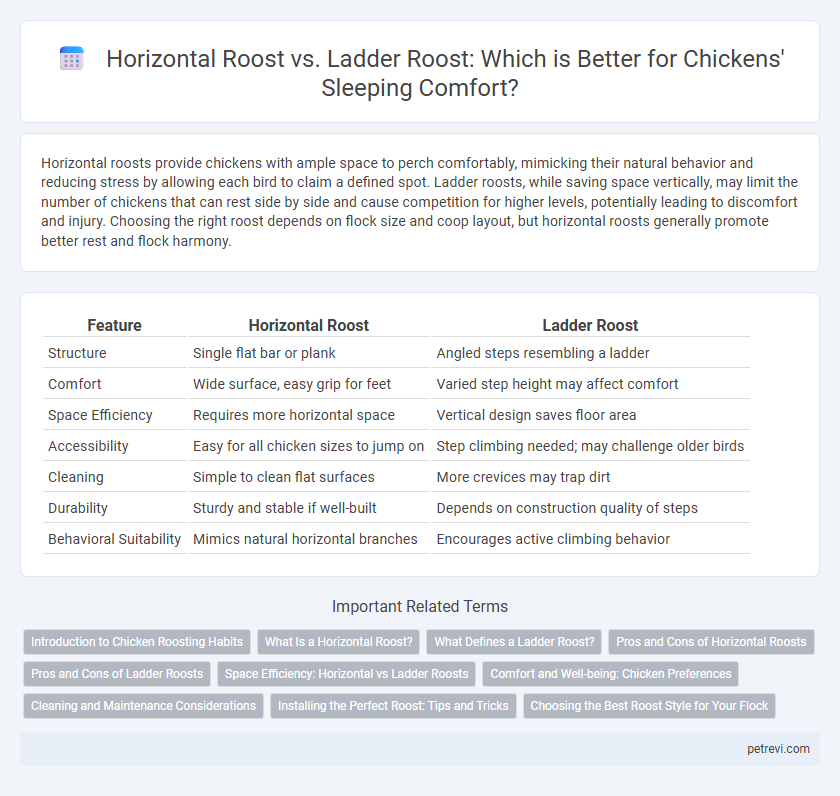Horizontal roosts provide chickens with ample space to perch comfortably, mimicking their natural behavior and reducing stress by allowing each bird to claim a defined spot. Ladder roosts, while saving space vertically, may limit the number of chickens that can rest side by side and cause competition for higher levels, potentially leading to discomfort and injury. Choosing the right roost depends on flock size and coop layout, but horizontal roosts generally promote better rest and flock harmony.
Table of Comparison
| Feature | Horizontal Roost | Ladder Roost |
|---|---|---|
| Structure | Single flat bar or plank | Angled steps resembling a ladder |
| Comfort | Wide surface, easy grip for feet | Varied step height may affect comfort |
| Space Efficiency | Requires more horizontal space | Vertical design saves floor area |
| Accessibility | Easy for all chicken sizes to jump on | Step climbing needed; may challenge older birds |
| Cleaning | Simple to clean flat surfaces | More crevices may trap dirt |
| Durability | Sturdy and stable if well-built | Depends on construction quality of steps |
| Behavioral Suitability | Mimics natural horizontal branches | Encourages active climbing behavior |
Introduction to Chicken Roosting Habits
Chickens exhibit natural roosting behaviors that involve perching off the ground to stay safe and comfortable during sleep. Horizontal roosts mimic tree branches, allowing chickens to grip with their feet, while ladder roosts provide flat steps that offer varying comfort and stability. Understanding these differences helps optimize coop design for better chicken health and reduced stress.
What Is a Horizontal Roost?
A horizontal roost is a flat, horizontal perch where chickens sleep, designed to mimic their natural behavior of resting on tree branches. Typically made from wood or metal, it provides a stable and spacious surface for chickens to balance and sleep comfortably. This type of roost supports the birds' feet, helping prevent foot injuries and promoting better rest compared to ladder roosts.
What Defines a Ladder Roost?
A ladder roost for chickens consists of evenly spaced horizontal bars arranged vertically like a ladder, allowing birds to climb and select their preferred perch height. This design mimics natural tree branches, promoting healthy foot grip and comfort during rest. Ladder roosts optimize space by accommodating multiple chickens at different levels, reducing crowding and enhancing air circulation.
Pros and Cons of Horizontal Roosts
Horizontal roosts provide chickens with ample space to perch comfortably, promoting natural sleeping behavior and reducing stress. They are easier to clean and maintain, but can require more horizontal space within the coop compared to ladder roosts. However, horizontal roosts may pose challenges for younger or less agile chickens to access, potentially leading to uneven occupancy.
Pros and Cons of Ladder Roosts
Ladder roosts provide easier access for chickens, especially younger or smaller birds, reducing the risk of injury from jumping down compared to horizontal roosts. The angled design encourages natural perching behavior while saving space in compact coops, but ladder roosts may accumulate more droppings on the steps, requiring frequent cleaning. Some chickens find ladder roosts less stable or comfortable than flat bars, which could affect their sleep quality and overall well-being.
Space Efficiency: Horizontal vs Ladder Roosts
Horizontal roosts maximize space by providing long, continuous bars that allow multiple chickens to sleep side by side, optimizing perch area within limited coop dimensions. Ladder roosts offer vertical stacking, effectively using height to increase capacity without expanding floor space, ideal for smaller footprints. Choosing between horizontal or ladder roosts depends on coop size and flock density, balancing horizontal perch length against vertical space utilization for efficient chicken rest.
Comfort and Well-being: Chicken Preferences
Chicken preferences for roosting prioritize comfort and well-being, with horizontal roosts often providing a more natural and stable perch that mimics branches found in the wild. Ladder roosts can be functional but may cause discomfort or increased stress due to less secure footing and unnatural angles. Ensuring roosts accommodate the chicken's natural sleeping posture supports better rest and overall health.
Cleaning and Maintenance Considerations
Horizontal roosts offer simpler cleaning due to their straightforward design, allowing easy access for scrubbing and waste removal, which reduces bacterial buildup. Ladder roosts, with their angled rungs and confined spaces, often accumulate droppings in hard-to-reach areas, requiring more meticulous maintenance to prevent ammonia buildup. Regular inspection and prompt cleaning of both roost types are essential for maintaining chicken health and hygiene in the coop.
Installing the Perfect Roost: Tips and Tricks
For installing the perfect chicken roost, horizontal roosts provide a natural perch width of 2 to 4 inches, promoting foot health and comfort, while ladder roosts save space with angled rungs but require secure attachment to prevent wobbling. Use untreated, smooth wood to avoid splinters and ensure easy cleaning, positioning roosts at least 18 inches above the floor to reduce moisture and parasites. Space roosts 12 to 15 inches apart to minimize overcrowding and encourage healthy sleeping patterns in flock behavior.
Choosing the Best Roost Style for Your Flock
Horizontal roosts offer ample space and natural perch angles that promote foot health and reduce stress among chickens, making them ideal for larger flocks seeking comfort and stability. Ladder roosts maximize vertical space, benefiting small coops with limited floor area, but may cause difficulty for heavier birds or those with mobility issues. Selecting the best roost style depends on flock size, bird weight, coop dimensions, and the chickens' ability to navigate elevation changes safely.
Horizontal Roost vs Ladder Roost for Chicken Sleeping Infographic

 petrevi.com
petrevi.com